Professional Communication Practice: Fuji Xerox Accounting Report
VerifiedAdded on 2020/02/18
|8
|1859
|39
Report
AI Summary
This report delves into the accounting scandal at Fuji Xerox, detailing the fraudulent activities and financial irregularities that plagued the company. It examines the management accounting issues, including the overstatement of revenue through abusive service agreements and fictitious transactions, which resulted in significant financial losses and a damaged reputation. The report identifies the root causes of the scandal, such as a culture of prioritizing sales over ethical conduct and weak internal controls, including lack of transparency in reporting lines. It highlights specific financial issues, such as the removal of auditors and misuse of corporate funds. The report concludes with recommendations for improved financial controls, including segregation of duties, revenue management strategies, and transparent remuneration policies, to prevent similar incidents from happening in the future. The analysis is based on the provided student assignment, which is available on Desklib.
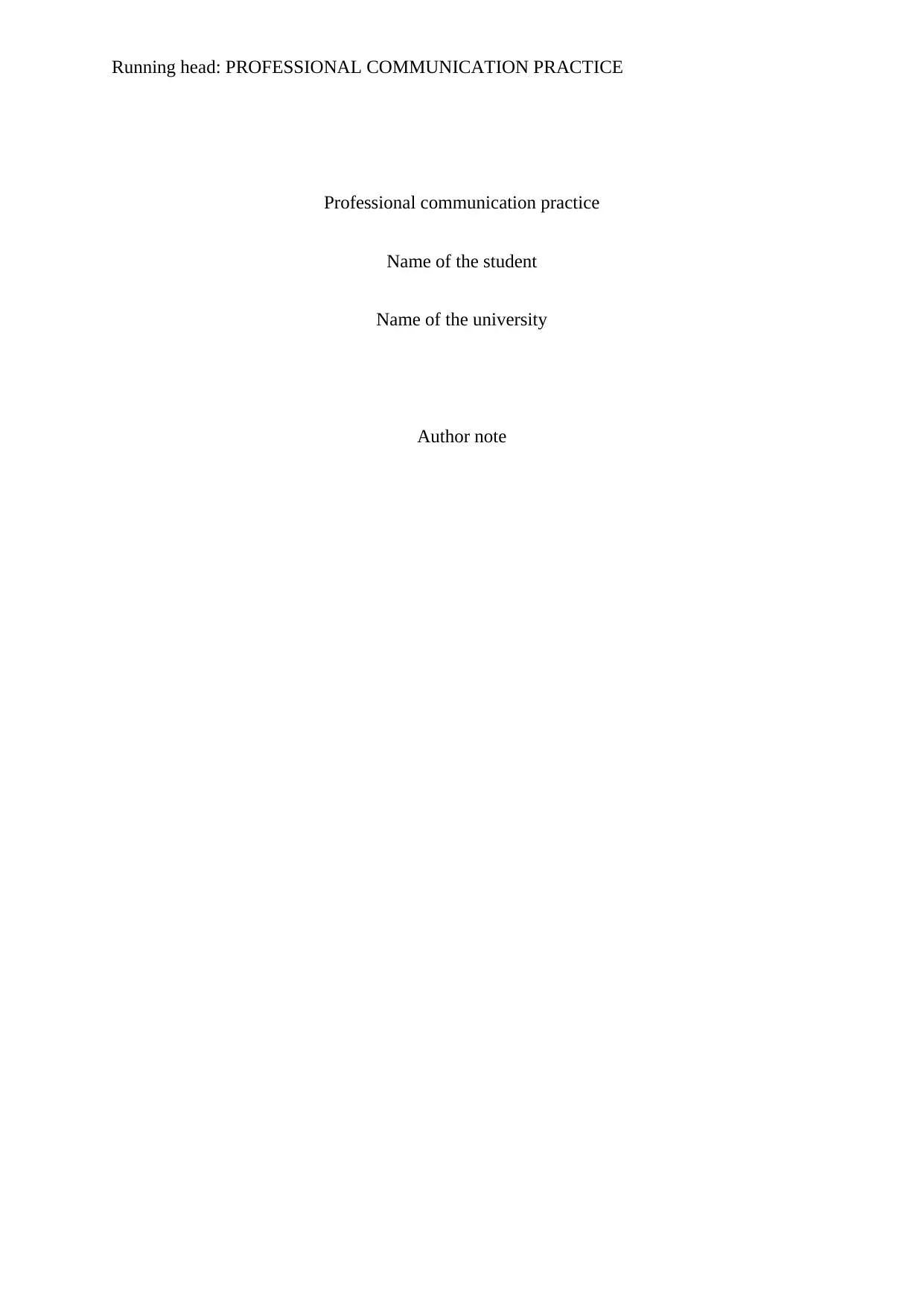
Running head: PROFESSIONAL COMMUNICATION PRACTICE
Professional communication practice
Name of the student
Name of the university
Author note
Professional communication practice
Name of the student
Name of the university
Author note
Paraphrase This Document
Need a fresh take? Get an instant paraphrase of this document with our AI Paraphraser
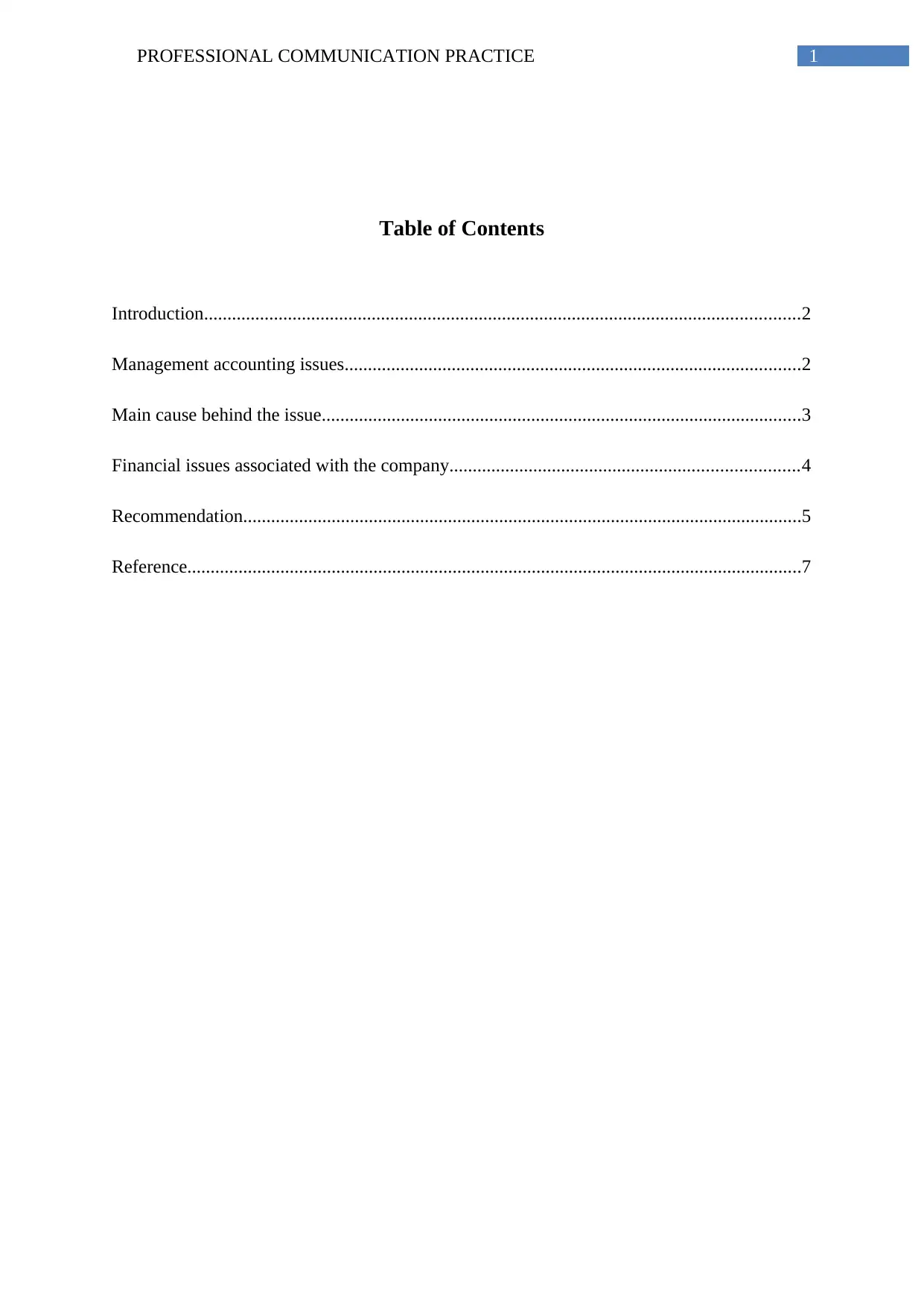
1PROFESSIONAL COMMUNICATION PRACTICE
Table of Contents
Introduction................................................................................................................................2
Management accounting issues..................................................................................................2
Main cause behind the issue.......................................................................................................3
Financial issues associated with the company...........................................................................4
Recommendation........................................................................................................................5
Reference....................................................................................................................................7
Table of Contents
Introduction................................................................................................................................2
Management accounting issues..................................................................................................2
Main cause behind the issue.......................................................................................................3
Financial issues associated with the company...........................................................................4
Recommendation........................................................................................................................5
Reference....................................................................................................................................7
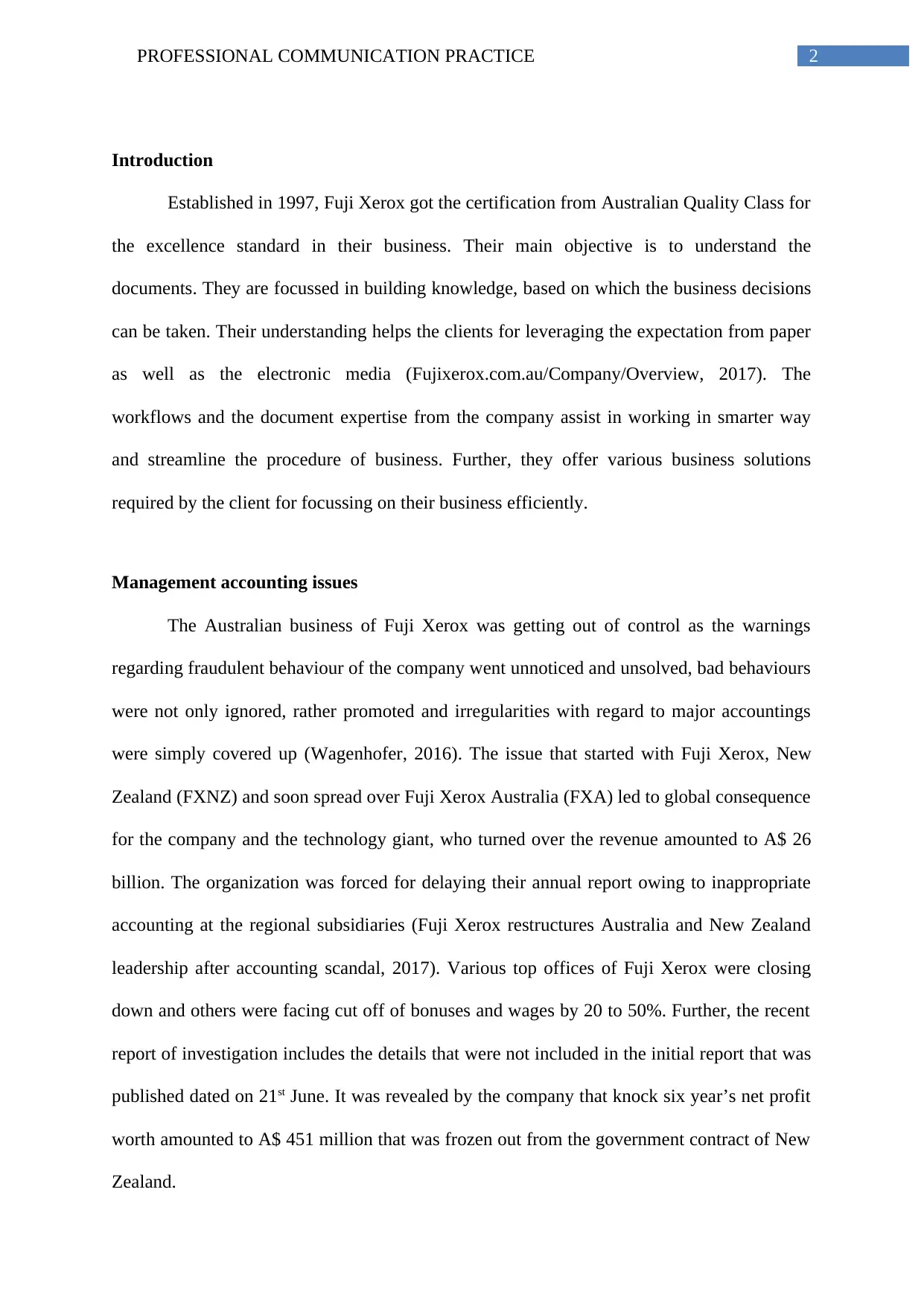
2PROFESSIONAL COMMUNICATION PRACTICE
Introduction
Established in 1997, Fuji Xerox got the certification from Australian Quality Class for
the excellence standard in their business. Their main objective is to understand the
documents. They are focussed in building knowledge, based on which the business decisions
can be taken. Their understanding helps the clients for leveraging the expectation from paper
as well as the electronic media (Fujixerox.com.au/Company/Overview, 2017). The
workflows and the document expertise from the company assist in working in smarter way
and streamline the procedure of business. Further, they offer various business solutions
required by the client for focussing on their business efficiently.
Management accounting issues
The Australian business of Fuji Xerox was getting out of control as the warnings
regarding fraudulent behaviour of the company went unnoticed and unsolved, bad behaviours
were not only ignored, rather promoted and irregularities with regard to major accountings
were simply covered up (Wagenhofer, 2016). The issue that started with Fuji Xerox, New
Zealand (FXNZ) and soon spread over Fuji Xerox Australia (FXA) led to global consequence
for the company and the technology giant, who turned over the revenue amounted to A$ 26
billion. The organization was forced for delaying their annual report owing to inappropriate
accounting at the regional subsidiaries (Fuji Xerox restructures Australia and New Zealand
leadership after accounting scandal, 2017). Various top offices of Fuji Xerox were closing
down and others were facing cut off of bonuses and wages by 20 to 50%. Further, the recent
report of investigation includes the details that were not included in the initial report that was
published dated on 21st June. It was revealed by the company that knock six year’s net profit
worth amounted to A$ 451 million that was frozen out from the government contract of New
Zealand.
Introduction
Established in 1997, Fuji Xerox got the certification from Australian Quality Class for
the excellence standard in their business. Their main objective is to understand the
documents. They are focussed in building knowledge, based on which the business decisions
can be taken. Their understanding helps the clients for leveraging the expectation from paper
as well as the electronic media (Fujixerox.com.au/Company/Overview, 2017). The
workflows and the document expertise from the company assist in working in smarter way
and streamline the procedure of business. Further, they offer various business solutions
required by the client for focussing on their business efficiently.
Management accounting issues
The Australian business of Fuji Xerox was getting out of control as the warnings
regarding fraudulent behaviour of the company went unnoticed and unsolved, bad behaviours
were not only ignored, rather promoted and irregularities with regard to major accountings
were simply covered up (Wagenhofer, 2016). The issue that started with Fuji Xerox, New
Zealand (FXNZ) and soon spread over Fuji Xerox Australia (FXA) led to global consequence
for the company and the technology giant, who turned over the revenue amounted to A$ 26
billion. The organization was forced for delaying their annual report owing to inappropriate
accounting at the regional subsidiaries (Fuji Xerox restructures Australia and New Zealand
leadership after accounting scandal, 2017). Various top offices of Fuji Xerox were closing
down and others were facing cut off of bonuses and wages by 20 to 50%. Further, the recent
report of investigation includes the details that were not included in the initial report that was
published dated on 21st June. It was revealed by the company that knock six year’s net profit
worth amounted to A$ 451 million that was frozen out from the government contract of New
Zealand.
⊘ This is a preview!⊘
Do you want full access?
Subscribe today to unlock all pages.

Trusted by 1+ million students worldwide
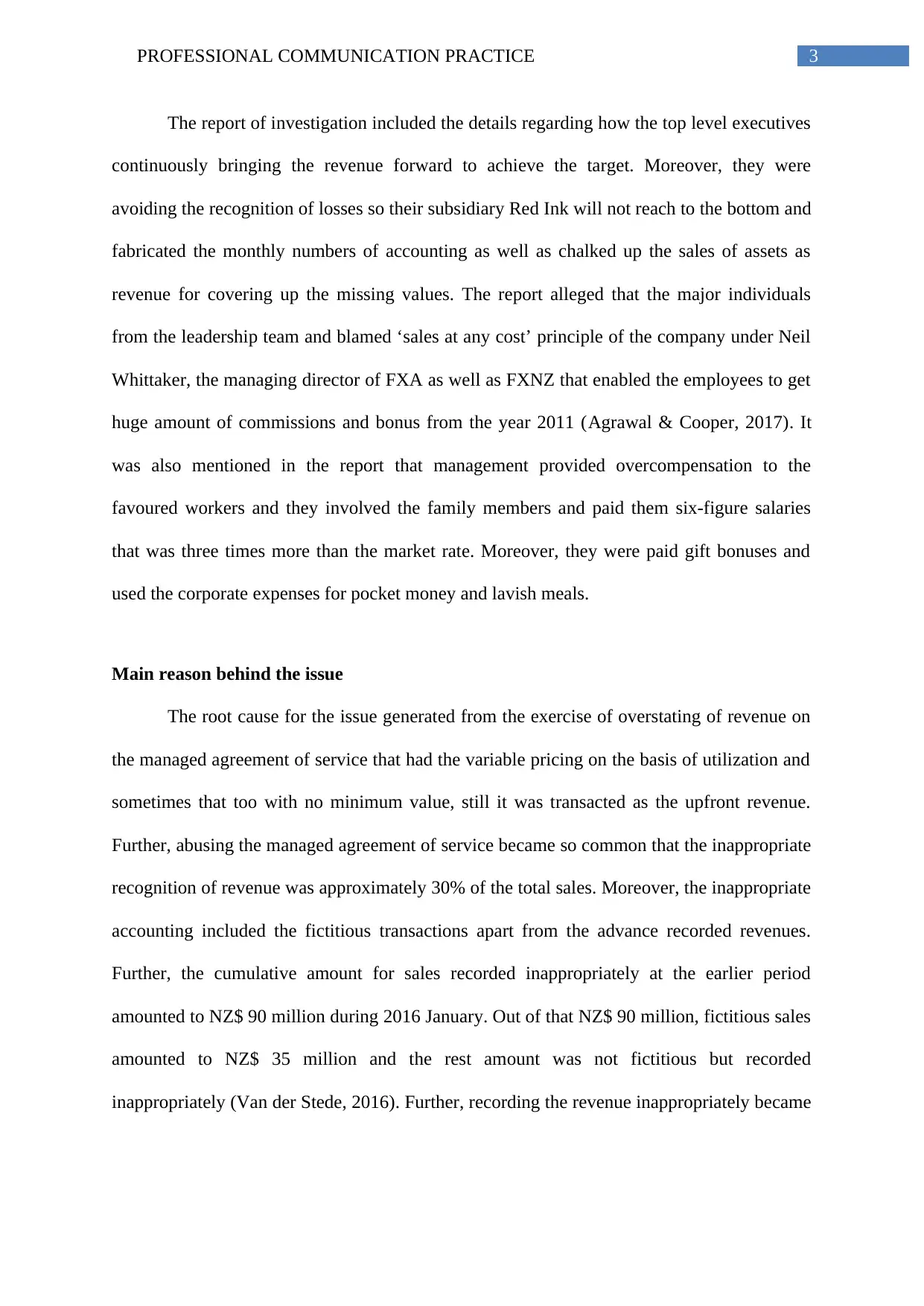
3PROFESSIONAL COMMUNICATION PRACTICE
The report of investigation included the details regarding how the top level executives
continuously bringing the revenue forward to achieve the target. Moreover, they were
avoiding the recognition of losses so their subsidiary Red Ink will not reach to the bottom and
fabricated the monthly numbers of accounting as well as chalked up the sales of assets as
revenue for covering up the missing values. The report alleged that the major individuals
from the leadership team and blamed ‘sales at any cost’ principle of the company under Neil
Whittaker, the managing director of FXA as well as FXNZ that enabled the employees to get
huge amount of commissions and bonus from the year 2011 (Agrawal & Cooper, 2017). It
was also mentioned in the report that management provided overcompensation to the
favoured workers and they involved the family members and paid them six-figure salaries
that was three times more than the market rate. Moreover, they were paid gift bonuses and
used the corporate expenses for pocket money and lavish meals.
Main reason behind the issue
The root cause for the issue generated from the exercise of overstating of revenue on
the managed agreement of service that had the variable pricing on the basis of utilization and
sometimes that too with no minimum value, still it was transacted as the upfront revenue.
Further, abusing the managed agreement of service became so common that the inappropriate
recognition of revenue was approximately 30% of the total sales. Moreover, the inappropriate
accounting included the fictitious transactions apart from the advance recorded revenues.
Further, the cumulative amount for sales recorded inappropriately at the earlier period
amounted to NZ$ 90 million during 2016 January. Out of that NZ$ 90 million, fictitious sales
amounted to NZ$ 35 million and the rest amount was not fictitious but recorded
inappropriately (Van der Stede, 2016). Further, recording the revenue inappropriately became
The report of investigation included the details regarding how the top level executives
continuously bringing the revenue forward to achieve the target. Moreover, they were
avoiding the recognition of losses so their subsidiary Red Ink will not reach to the bottom and
fabricated the monthly numbers of accounting as well as chalked up the sales of assets as
revenue for covering up the missing values. The report alleged that the major individuals
from the leadership team and blamed ‘sales at any cost’ principle of the company under Neil
Whittaker, the managing director of FXA as well as FXNZ that enabled the employees to get
huge amount of commissions and bonus from the year 2011 (Agrawal & Cooper, 2017). It
was also mentioned in the report that management provided overcompensation to the
favoured workers and they involved the family members and paid them six-figure salaries
that was three times more than the market rate. Moreover, they were paid gift bonuses and
used the corporate expenses for pocket money and lavish meals.
Main reason behind the issue
The root cause for the issue generated from the exercise of overstating of revenue on
the managed agreement of service that had the variable pricing on the basis of utilization and
sometimes that too with no minimum value, still it was transacted as the upfront revenue.
Further, abusing the managed agreement of service became so common that the inappropriate
recognition of revenue was approximately 30% of the total sales. Moreover, the inappropriate
accounting included the fictitious transactions apart from the advance recorded revenues.
Further, the cumulative amount for sales recorded inappropriately at the earlier period
amounted to NZ$ 90 million during 2016 January. Out of that NZ$ 90 million, fictitious sales
amounted to NZ$ 35 million and the rest amount was not fictitious but recorded
inappropriately (Van der Stede, 2016). Further, recording the revenue inappropriately became
Paraphrase This Document
Need a fresh take? Get an instant paraphrase of this document with our AI Paraphraser

4PROFESSIONAL COMMUNICATION PRACTICE
the regular practice of the company and took place for 70% of the contracts over the duration
of six year. The abusive accounting further overlooked that early recognition of revenue.
Further, instances found for advance sales that were recorded twice and fictitious
sales recording for achieving the target of monthly performance. Moreover, the promotional
giveaways and free products were recorded as sales. Lack in credit policies assisted in green
light orders from the risky clients as the credit investigation performed for 10% only of the
total transactions. While the financial figures were found to be incorrect, they were just
ignored. Further, to clean up the issues and avoid the detection, the company transacted the
non-operating transactions and sales of the assets as revenue for minimizing the inappropriate
accounting impact that were susceptible to accounting audit at closing of the period. This led
to the external appearance as the financial condition and financial activities improved during
the fiscal year and the company reported higher revenue as compared to the actual revenue
(Bebbington, Unerman & O'Dwyer, 2014). It further led to the establishment of disastrous
culture and the report claimed that the employees and the executives of the company lacked
the sense of honesty and ethics while preparing the annual report of the company.
Financial issues associated with the company
The auditor of the company, Ernst & Young were removed in 2016 July and replaced
by the KPMG. The payout to the managing director amounted to million dollar came in focus
irrespective of various allegations regarding impropriety by the director, who used the
pressures for rebelling and creating the circumstances where the opposition was next to
impossible. The scrutiny of the corporate credit card revealed that the director and various
other members repeatedly used the credit card for the payment of dinner and lunch at various
high-end places. Further, over the time period of 10 months 3 executives from the company
spent huge amounts that amounted to $ 50,000 over 41 dinners that averaged $ 1,233 per
the regular practice of the company and took place for 70% of the contracts over the duration
of six year. The abusive accounting further overlooked that early recognition of revenue.
Further, instances found for advance sales that were recorded twice and fictitious
sales recording for achieving the target of monthly performance. Moreover, the promotional
giveaways and free products were recorded as sales. Lack in credit policies assisted in green
light orders from the risky clients as the credit investigation performed for 10% only of the
total transactions. While the financial figures were found to be incorrect, they were just
ignored. Further, to clean up the issues and avoid the detection, the company transacted the
non-operating transactions and sales of the assets as revenue for minimizing the inappropriate
accounting impact that were susceptible to accounting audit at closing of the period. This led
to the external appearance as the financial condition and financial activities improved during
the fiscal year and the company reported higher revenue as compared to the actual revenue
(Bebbington, Unerman & O'Dwyer, 2014). It further led to the establishment of disastrous
culture and the report claimed that the employees and the executives of the company lacked
the sense of honesty and ethics while preparing the annual report of the company.
Financial issues associated with the company
The auditor of the company, Ernst & Young were removed in 2016 July and replaced
by the KPMG. The payout to the managing director amounted to million dollar came in focus
irrespective of various allegations regarding impropriety by the director, who used the
pressures for rebelling and creating the circumstances where the opposition was next to
impossible. The scrutiny of the corporate credit card revealed that the director and various
other members repeatedly used the credit card for the payment of dinner and lunch at various
high-end places. Further, over the time period of 10 months 3 executives from the company
spent huge amounts that amounted to $ 50,000 over 41 dinners that averaged $ 1,233 per
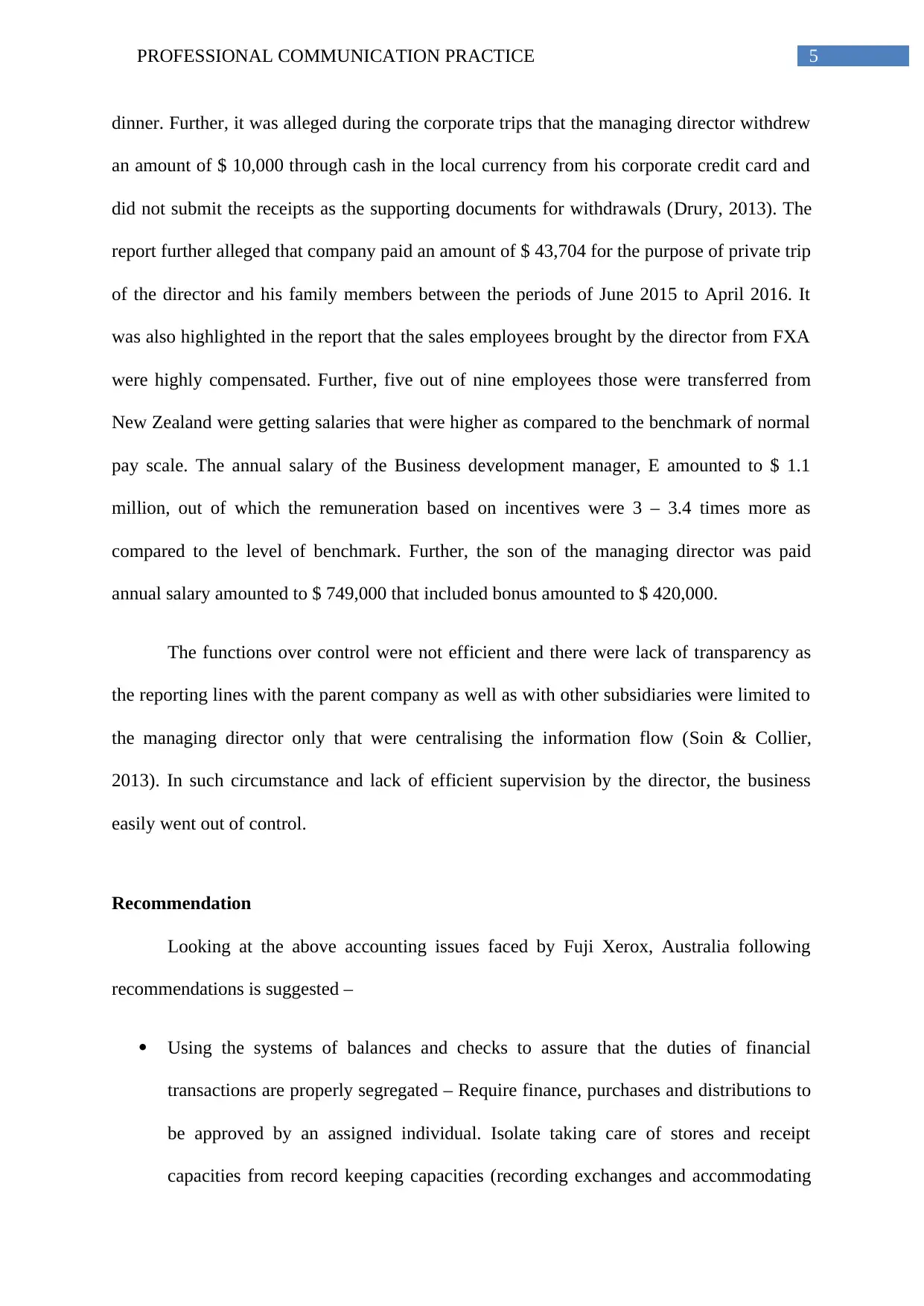
5PROFESSIONAL COMMUNICATION PRACTICE
dinner. Further, it was alleged during the corporate trips that the managing director withdrew
an amount of $ 10,000 through cash in the local currency from his corporate credit card and
did not submit the receipts as the supporting documents for withdrawals (Drury, 2013). The
report further alleged that company paid an amount of $ 43,704 for the purpose of private trip
of the director and his family members between the periods of June 2015 to April 2016. It
was also highlighted in the report that the sales employees brought by the director from FXA
were highly compensated. Further, five out of nine employees those were transferred from
New Zealand were getting salaries that were higher as compared to the benchmark of normal
pay scale. The annual salary of the Business development manager, E amounted to $ 1.1
million, out of which the remuneration based on incentives were 3 – 3.4 times more as
compared to the level of benchmark. Further, the son of the managing director was paid
annual salary amounted to $ 749,000 that included bonus amounted to $ 420,000.
The functions over control were not efficient and there were lack of transparency as
the reporting lines with the parent company as well as with other subsidiaries were limited to
the managing director only that were centralising the information flow (Soin & Collier,
2013). In such circumstance and lack of efficient supervision by the director, the business
easily went out of control.
Recommendation
Looking at the above accounting issues faced by Fuji Xerox, Australia following
recommendations is suggested –
Using the systems of balances and checks to assure that the duties of financial
transactions are properly segregated – Require finance, purchases and distributions to
be approved by an assigned individual. Isolate taking care of stores and receipt
capacities from record keeping capacities (recording exchanges and accommodating
dinner. Further, it was alleged during the corporate trips that the managing director withdrew
an amount of $ 10,000 through cash in the local currency from his corporate credit card and
did not submit the receipts as the supporting documents for withdrawals (Drury, 2013). The
report further alleged that company paid an amount of $ 43,704 for the purpose of private trip
of the director and his family members between the periods of June 2015 to April 2016. It
was also highlighted in the report that the sales employees brought by the director from FXA
were highly compensated. Further, five out of nine employees those were transferred from
New Zealand were getting salaries that were higher as compared to the benchmark of normal
pay scale. The annual salary of the Business development manager, E amounted to $ 1.1
million, out of which the remuneration based on incentives were 3 – 3.4 times more as
compared to the level of benchmark. Further, the son of the managing director was paid
annual salary amounted to $ 749,000 that included bonus amounted to $ 420,000.
The functions over control were not efficient and there were lack of transparency as
the reporting lines with the parent company as well as with other subsidiaries were limited to
the managing director only that were centralising the information flow (Soin & Collier,
2013). In such circumstance and lack of efficient supervision by the director, the business
easily went out of control.
Recommendation
Looking at the above accounting issues faced by Fuji Xerox, Australia following
recommendations is suggested –
Using the systems of balances and checks to assure that the duties of financial
transactions are properly segregated – Require finance, purchases and distributions to
be approved by an assigned individual. Isolate taking care of stores and receipt
capacities from record keeping capacities (recording exchanges and accommodating
⊘ This is a preview!⊘
Do you want full access?
Subscribe today to unlock all pages.

Trusted by 1+ million students worldwide
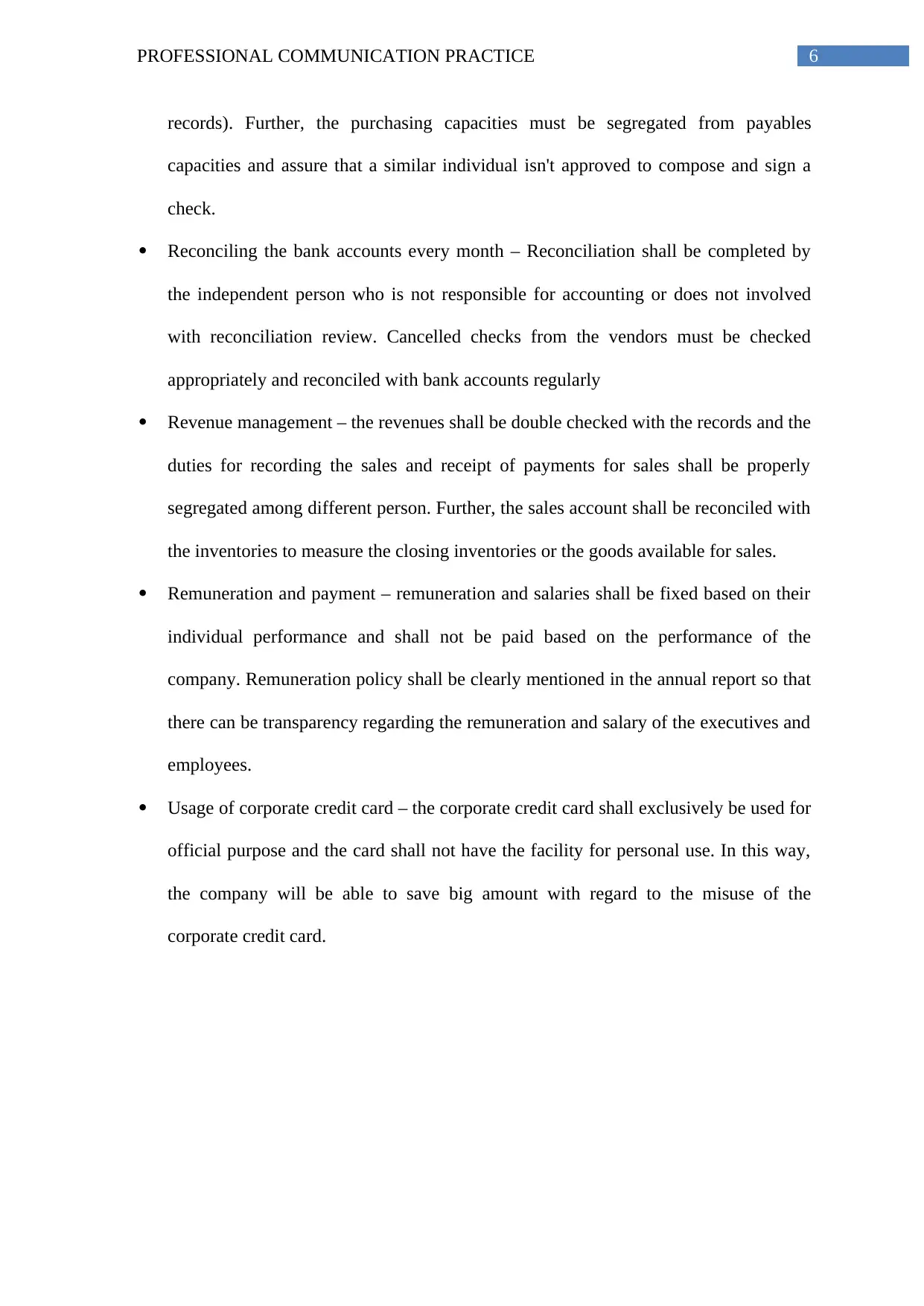
6PROFESSIONAL COMMUNICATION PRACTICE
records). Further, the purchasing capacities must be segregated from payables
capacities and assure that a similar individual isn't approved to compose and sign a
check.
Reconciling the bank accounts every month – Reconciliation shall be completed by
the independent person who is not responsible for accounting or does not involved
with reconciliation review. Cancelled checks from the vendors must be checked
appropriately and reconciled with bank accounts regularly
Revenue management – the revenues shall be double checked with the records and the
duties for recording the sales and receipt of payments for sales shall be properly
segregated among different person. Further, the sales account shall be reconciled with
the inventories to measure the closing inventories or the goods available for sales.
Remuneration and payment – remuneration and salaries shall be fixed based on their
individual performance and shall not be paid based on the performance of the
company. Remuneration policy shall be clearly mentioned in the annual report so that
there can be transparency regarding the remuneration and salary of the executives and
employees.
Usage of corporate credit card – the corporate credit card shall exclusively be used for
official purpose and the card shall not have the facility for personal use. In this way,
the company will be able to save big amount with regard to the misuse of the
corporate credit card.
records). Further, the purchasing capacities must be segregated from payables
capacities and assure that a similar individual isn't approved to compose and sign a
check.
Reconciling the bank accounts every month – Reconciliation shall be completed by
the independent person who is not responsible for accounting or does not involved
with reconciliation review. Cancelled checks from the vendors must be checked
appropriately and reconciled with bank accounts regularly
Revenue management – the revenues shall be double checked with the records and the
duties for recording the sales and receipt of payments for sales shall be properly
segregated among different person. Further, the sales account shall be reconciled with
the inventories to measure the closing inventories or the goods available for sales.
Remuneration and payment – remuneration and salaries shall be fixed based on their
individual performance and shall not be paid based on the performance of the
company. Remuneration policy shall be clearly mentioned in the annual report so that
there can be transparency regarding the remuneration and salary of the executives and
employees.
Usage of corporate credit card – the corporate credit card shall exclusively be used for
official purpose and the card shall not have the facility for personal use. In this way,
the company will be able to save big amount with regard to the misuse of the
corporate credit card.
Paraphrase This Document
Need a fresh take? Get an instant paraphrase of this document with our AI Paraphraser
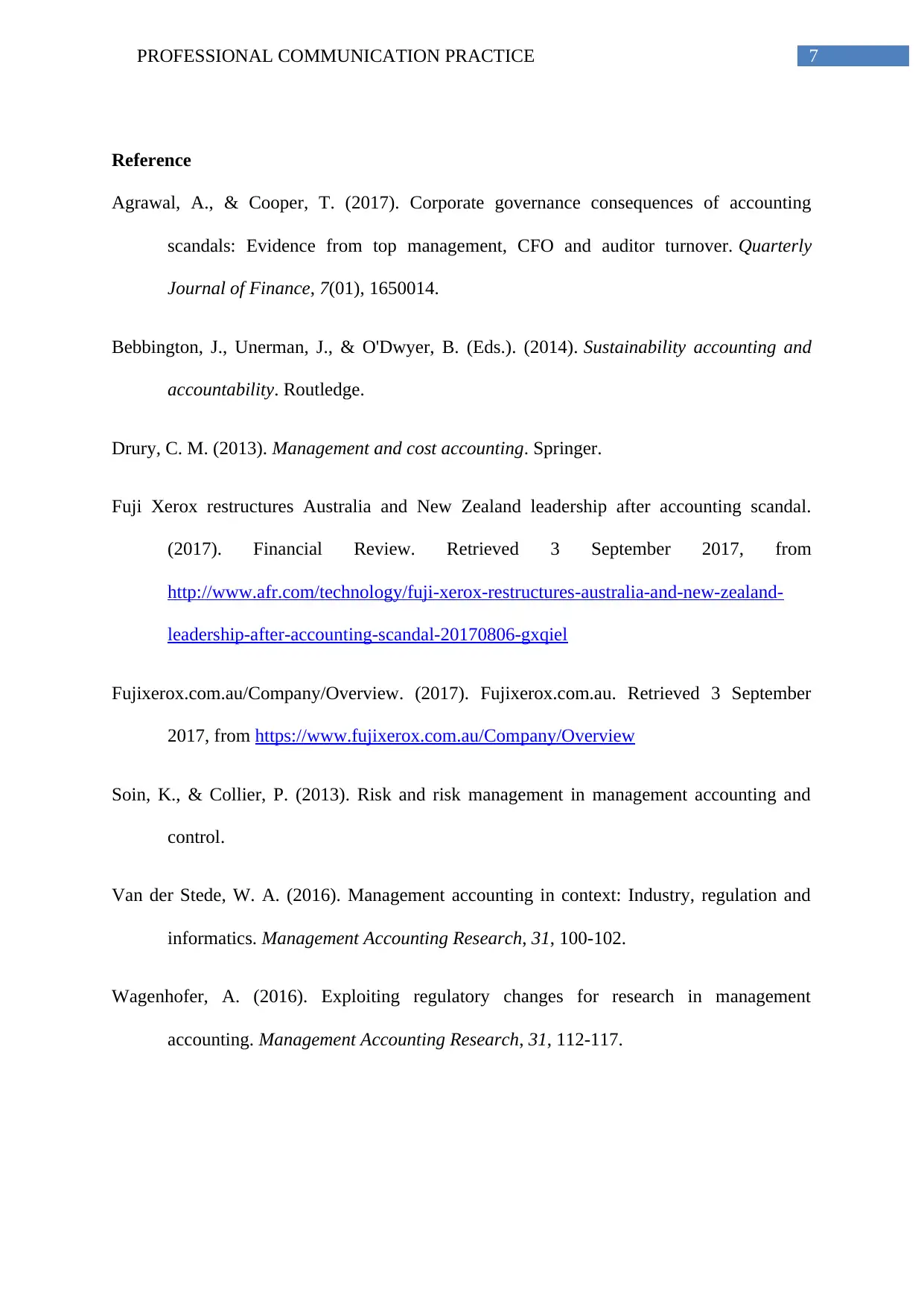
7PROFESSIONAL COMMUNICATION PRACTICE
Reference
Agrawal, A., & Cooper, T. (2017). Corporate governance consequences of accounting
scandals: Evidence from top management, CFO and auditor turnover. Quarterly
Journal of Finance, 7(01), 1650014.
Bebbington, J., Unerman, J., & O'Dwyer, B. (Eds.). (2014). Sustainability accounting and
accountability. Routledge.
Drury, C. M. (2013). Management and cost accounting. Springer.
Fuji Xerox restructures Australia and New Zealand leadership after accounting scandal.
(2017). Financial Review. Retrieved 3 September 2017, from
http://www.afr.com/technology/fuji-xerox-restructures-australia-and-new-zealand-
leadership-after-accounting-scandal-20170806-gxqiel
Fujixerox.com.au/Company/Overview. (2017). Fujixerox.com.au. Retrieved 3 September
2017, from https://www.fujixerox.com.au/Company/Overview
Soin, K., & Collier, P. (2013). Risk and risk management in management accounting and
control.
Van der Stede, W. A. (2016). Management accounting in context: Industry, regulation and
informatics. Management Accounting Research, 31, 100-102.
Wagenhofer, A. (2016). Exploiting regulatory changes for research in management
accounting. Management Accounting Research, 31, 112-117.
Reference
Agrawal, A., & Cooper, T. (2017). Corporate governance consequences of accounting
scandals: Evidence from top management, CFO and auditor turnover. Quarterly
Journal of Finance, 7(01), 1650014.
Bebbington, J., Unerman, J., & O'Dwyer, B. (Eds.). (2014). Sustainability accounting and
accountability. Routledge.
Drury, C. M. (2013). Management and cost accounting. Springer.
Fuji Xerox restructures Australia and New Zealand leadership after accounting scandal.
(2017). Financial Review. Retrieved 3 September 2017, from
http://www.afr.com/technology/fuji-xerox-restructures-australia-and-new-zealand-
leadership-after-accounting-scandal-20170806-gxqiel
Fujixerox.com.au/Company/Overview. (2017). Fujixerox.com.au. Retrieved 3 September
2017, from https://www.fujixerox.com.au/Company/Overview
Soin, K., & Collier, P. (2013). Risk and risk management in management accounting and
control.
Van der Stede, W. A. (2016). Management accounting in context: Industry, regulation and
informatics. Management Accounting Research, 31, 100-102.
Wagenhofer, A. (2016). Exploiting regulatory changes for research in management
accounting. Management Accounting Research, 31, 112-117.
1 out of 8
Related Documents
Your All-in-One AI-Powered Toolkit for Academic Success.
+13062052269
info@desklib.com
Available 24*7 on WhatsApp / Email
![[object Object]](/_next/static/media/star-bottom.7253800d.svg)
Unlock your academic potential
Copyright © 2020–2025 A2Z Services. All Rights Reserved. Developed and managed by ZUCOL.





